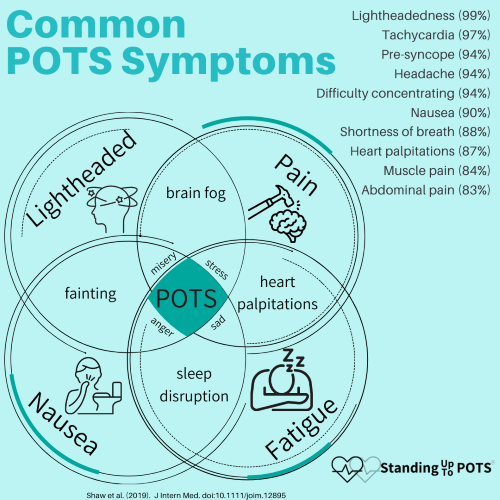Common POTS Symptoms
POTS Symptoms
POTS is a chronic illness that is often invisible to the untrained eye. A person with POTS may not have all of these symptoms, and some may be more sporadic while others are constant. Every person with POTS is different, and we need to receive individualized treatment to get the best clinical outcome.
Postural tachycardia: heart rate above 120 beats per minute while standing or an increase in heart rate by 30 beats per minute for an adult or 40 beats per minute in an adolescent when going from laying to standing in the presence of other symptoms.
Orthostatic intolerance: increased symptoms when upright compared with laying or sitting.
Neurological Symptoms Related to Blood Pooling
- Dizziness
- Lightheadedness
- Headaches
- Migraines
- Brain fog
- Palpitations
- Tremor
- Generalized weakness
- Blurred vision
- Exercise intolerance
- Fatigue
- Sleep disturbance
Pain Related to POTS
- Neuropathic pain
- Abdominal pain
- Leg pain
- Hypersensitivity (skin, light, sound)
Gastrointestinal Symptoms of POTS
- Bloating
- Nausea
- Diarrhea
- Gastroparesis (stomach paralysis)
- Rapid gastric emptying
Other Symptoms
- Drug hypersensitivities are common

And the tests come back normal. Many blood and urine tests will be normal when people have POTS. Similarly, often MRIs, EKGs, and other tests are normal. This is frustrating for the patient, their family, and their healthcare provider as they seek a reason for the poor health.
Be sure that you are well hydrated. Children should consume 7-8 cups of fluid per day, in addition to the water that they get from eating watermelon, ice cream, Popsicles, etc. Adults should drink at least 1 L per day to see if symptoms resolve.
Consider trying the Standing Test at home or in your doctor’s office. If you know someone who has many of the symptoms listed above and you suspect POTS, try the Standing Test at home. It is really easy – all that you need is a watch and count the heart rate using the pulse.
Standing Test
1. Lay on your back for 5 minutes and be as still as possible. While still laying down, take the pulse and write it down.
2. Stand up still as possible for 2 minutes without leaning. Take the pulse while still standing. If there is no significant change in pulse, repeat continue standing up to 10 minutes, taking the pulse every 2 minutes.
POTS can be diagnosed a couple of ways:
If the heart rate is greater than 120 beats per minute at any point while standing, POTS might be indicated.
Adults age > 19, an increase in heart rate of 30 beats per minute or more between laying and standing may indicate POTS.
Children and teens age <19, an increase in heart rate of of 40 beats per minute or more when standing, it may be POTS.
You can use the Stand Test for POTS app to track changes in heart rate during this test. If you have an automatic blood pressure cuff at home, you can use it to monitor blood pressure and pulse for you. In many POTS patients, there will be a decrease in blood pressure by up to 20/10 mmHg when standing.
If after the Standing Test you still suspect POTS, please contact an autonomic specialist. You need to find a doctor who is a specialist in the autonomic nervous system, which is the system affected by POTS. Most autonomic specialists are either neurologists or cardiologists, but not all of them are familiar with POTS. Look for a neurologist or cardiologist who specializes in POTS.
Finding a Good Autonomic Physician
People with dysautonomia need a good autonomic physician to oversee their care. The following resources can help you find a good autonomic physician in your area who understands postural orthostatic tachycardia syndrome, or ask your doctor for a referral to a specialist close to you.
Physician Listing - Dysautonomia International
How to Find a Good Doctor gives excellent general advice for what to look for when you are choosing a new physician.
Once you find a good physician, be sure that you prepare for the appointment. Making a good impression is important, and bringing along as much information as possible will help you to hit the ground running. This is especially important when you have an invisible illness. Check out these preparation tips.